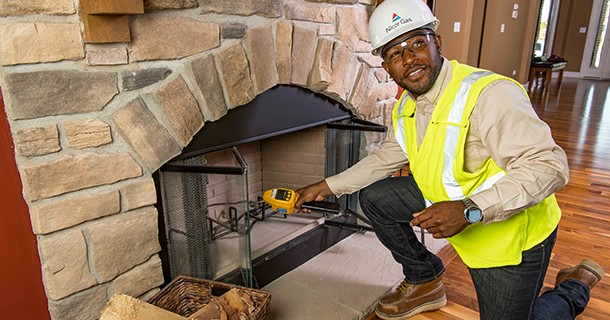Tips for Saving Money and Energy
Conservation Tips
If you'd like to better manage your energy bills, save energy and keep more money in your wallet, energy efficiency and conservation are a great place to start. Check out the conservation tips below and download our guide. It also includes resources for energy assistance and learning more about natural gas savings. You can find additional tips on the U.S. Department of Energy’s Energy Savers site.
If you’re thinking of converting to natural gas appliances or adding more, you can learn more about saving money and energy at Energy Star. See how natural gas can lower your carbon footprint with this calculator.
Ranges
- When you’re cooking, adjust the flame to fit the bottom of the pot or pan. Turning up the flame beyond the bottom only wastes energy.
- Keep the burner surfaces clean.
- Cover pots and pans with lids when cooking.
- Cook food at high heat to bring to temperature then reduce to complete cooking.
Sinks and Showers
- Fix leaky faucets.
- Install low volume showerheads and faucets.
Washers and Dryers
- Use a water-level setting that matches the size of the load you’re washing.
- Select the proper setting and time for the clothing type and load size.
- In your dryer, separate heavier clothes (towels, heavy cottons) from the lightweight fabrics (synthetics) for more efficient drying.
- Dry full loads, but be sure not to overload your dryer.
- Clean the dryer’s lint filter before every load.
- Don't add wet clothes during the drying cycle.
- Don't over-dry clothes. Use the automatic moisture control if your dryer has one, or select the appropriate amount of time on the automatic timer.
- Be sure the outside dryer vent is free of any obstructions and the vent cover fully opens when the dryer is in use.
Water Heaters and Furnaces
- Lower the temperature setting on your water heater to 120 degrees.
- Put an insulation wrap around the sides of your water heater. (But remember: Never put insulation on the top of the heater or near the bottom.)
- Add insulation in your attic.
- Lower the thermostat when no one is home.
- Install a programmable thermostat to automatically adjust the temperature each day.
- Clean or replace all filters at least once per month.
- Have the system inspected and maintained regularly.
- Keep heating and return vents free of all obstructions for proper airflow.
Seasonal Checkups
Make sure your furnace stays in cold-weather condition. We recommend an annual inspection by a qualified contractor, which should include:
- Making sure the blower bearings and blower motor are lubricated according to manufacturer’s instructions.
- Visually inspecting all vents, heat exchanger, and motor.
- Clearing the furnace area of any dust or combustible materials.
- Testing the thermostat.
- Cleaning dust from the blower compartment.
- Checking the flue to make sure it’s clean and open.
- Checking the pilot light, if your furnace has one.
Here are some things you can do:
- Have appliances professionally installed and serviced.
- Ensure your appliances are well ventilated. In particular, check the venting of your water heating system.
- The gas flame in your appliances should burn a healthy bright blue or blue-orange, never a sluggish yellow.
- If a pilot light goes out, follow the manufacturer’s instructions for relighting: turn off the appliance and allow any accumulated natural gas to vent before relighting.
We can help you locate a qualified HVAC dealer or plumber in your area.
Weatherization
Weatherization is one of the easiest ways to make your home more energy efficient. By making sure your home is sealed properly and that you’re not wasting water, you can drive down your energy costs.
If you’re looking for ways to get started weatherizing your home, the list of items below is a good place to start.
Outlet Gaskets
Place caulk or foam between the electrical box and drywall on switches and outlets located on exterior walls. Then place these foam gaskets behind the plates for a good, airtight seal.
Child Safety Caps
Promote energy conservation and child safety by keeping drafts and your child’s favorite toys away from unused electrical outlets.
Weather-Stripping
If you have an attic access located within your home, make sure the access door is insulated and seals tight, much like a refrigerator. Use weather-stripping and screen door latches for a snug seal.
Rope Caulk
Caulk is best for gaps and cracks less than about ¼” wide. If the caulked joint will be visible, consider using paintable caulk. Use a high-quality caulk to ensure durability and longevity.
Window Insulator Kit
Seals windows airtight, eliminates condensation, cold drafts and heat loss. The kit contains enough plastic shrink film and two-way tape to cover four average size windows. Use tape to hold the plastic film in place and then use a hair dryer to shrink film to form a smooth, tight finish inside a storm window.
Low Flow Shower Head and Sink Aerator
A family of four each showering five minutes a day can use about 700 gallons of water per week. Water conserving showerheads and faucet aerators can cut hot water use in half, saving that family 14,000 gallons of water a year.
Pipe Insulation
Insulated pipes keep the hot water that exists in the pipes warmer, meaning you won’t have to wait as long for hot water - reducing waste.
Water Heater Jacket Cover
A water heater jacket can reduce up to 15% off of the costs of heating water by preventing energy loss.
Silicone Caulk
Silicone caulk helps fill cracks and gaps where air can enter or escape your home.
Toilet Tank Displacement Device
Control the amount of water used to flush your toilet, saving hundreds of gallons of water per year.
Foundation Vent Cover
Help keep cold air out of your basement or crawl space by covering vents during the winter. Foundation vents help keep your floors warmer and ultimately your heating bills down.
Shower Head On/Off Switch
Turn off or lower the flow of your shower when you need less. Perfect for reducing water waste when shaving.`
Fiberglass Insulation
The insulation R-value you need depends on the climate and your heating and cooling system, but the higher the R-value, the greater the insulating effectiveness.
Are your natural gas-fueled appliances ready for change of season?
It is an excellent time to inspect appliances and schedule routine maintenance. As your natural gas needs change with the seasons, keep these tips in mind.
Your checklist:

- Hire a qualified specialist to inspect your furnace’s emergency shut-offs, controls and vents
- Clear all heating systems of flammable materials or debris that might have accumulated during the summer
- Check your vents for obstructions
- Replace air filters
- Lower your water heater to 120 degrees Fahrenheit
Don't do this:

- NEVER use a gas range as a space heater
- NEVER put a space heater near curtains or flammable objects
- NEVER leave the fan compartment door of your furnace open
Signs you need help:

- Pale or wavy gas flames
- Appliances that don’t vent outside
- Missing or damaged valves
- Visible corrosion, clogs or bad seals
- Soot near burners or vents
- Discolored burners, burner access doors or vents
Need financial assistance?

- Residential and Commercial Rebates
- Tennessee 2-1-1 Community Resources
- Low Income Home Energy Assistance Program (LIHEAP)
- Payment Arrangement



